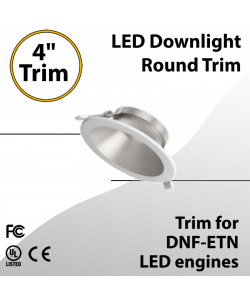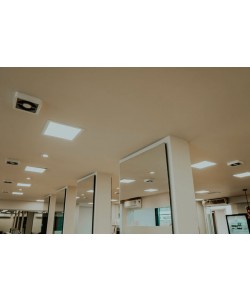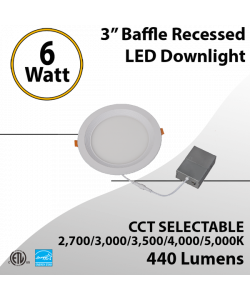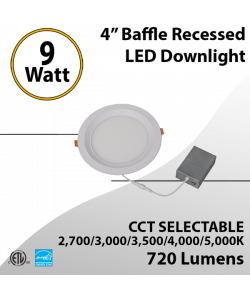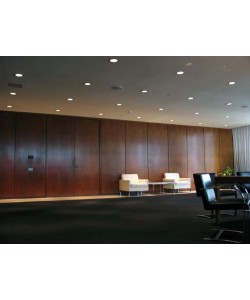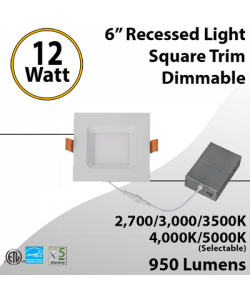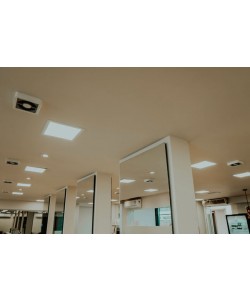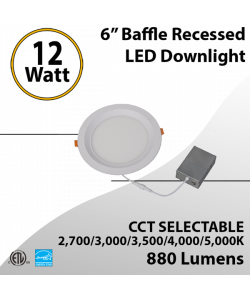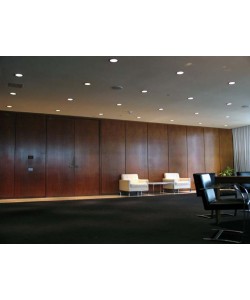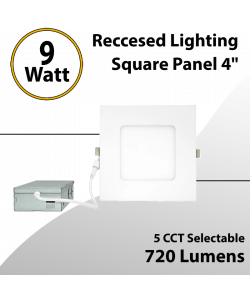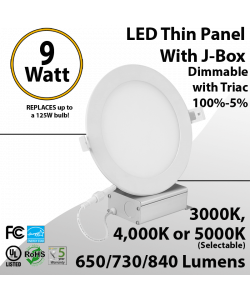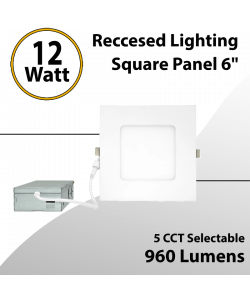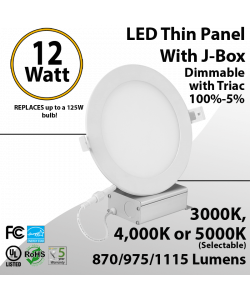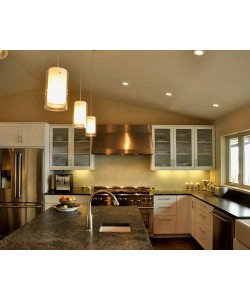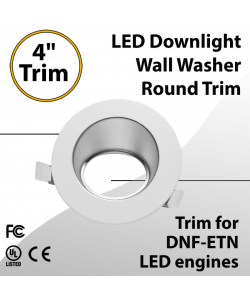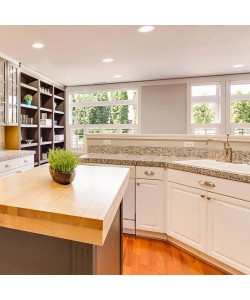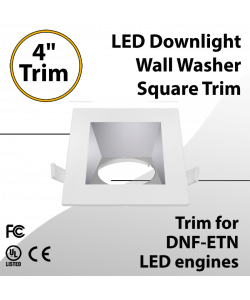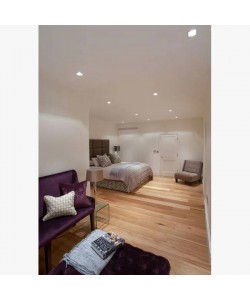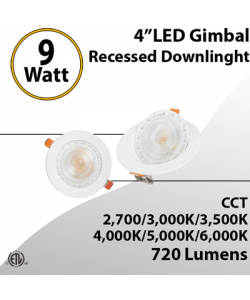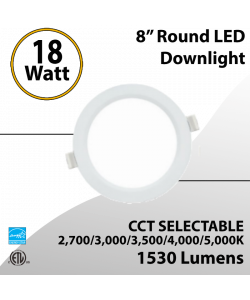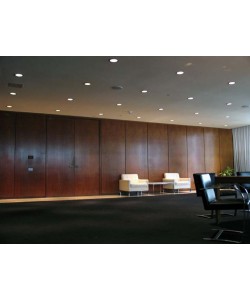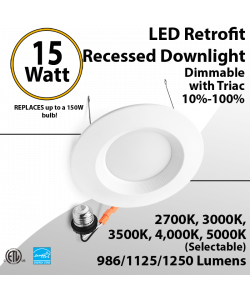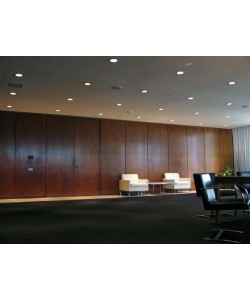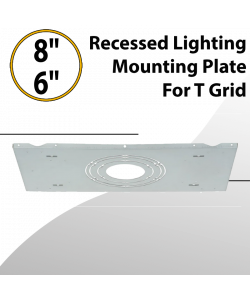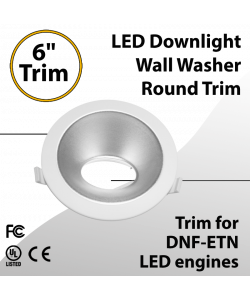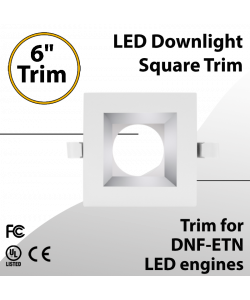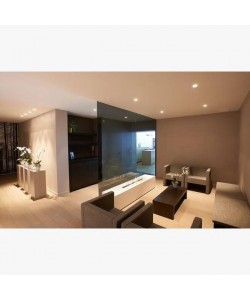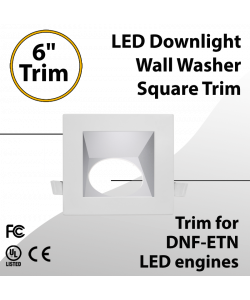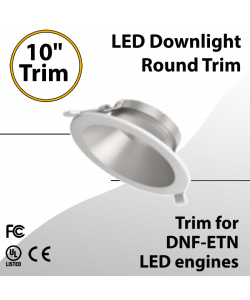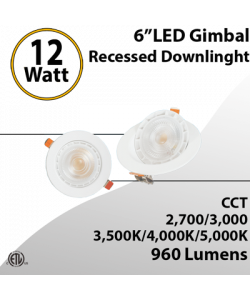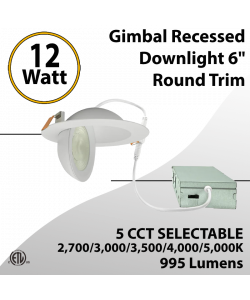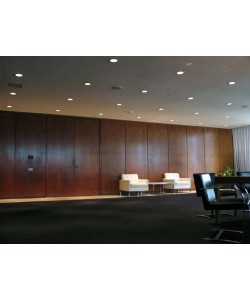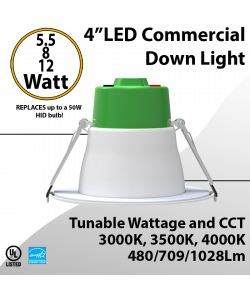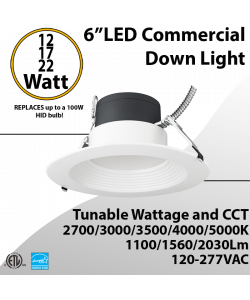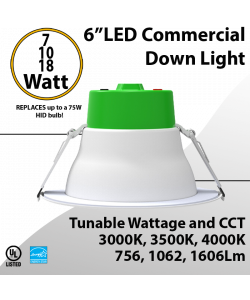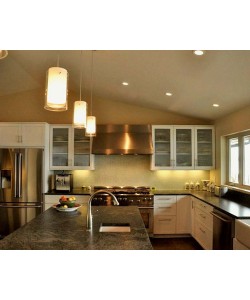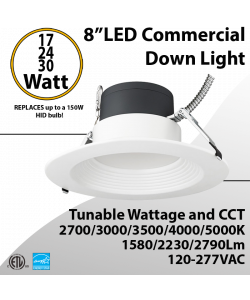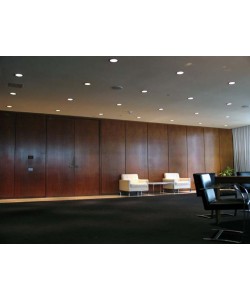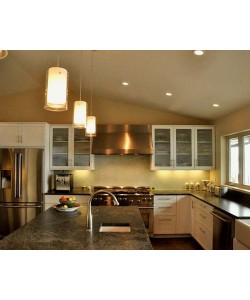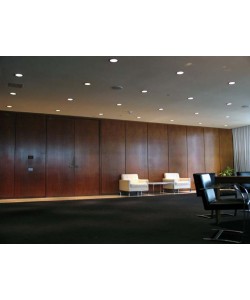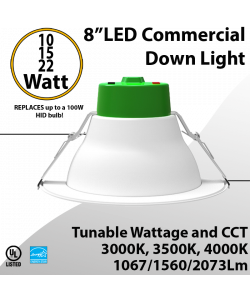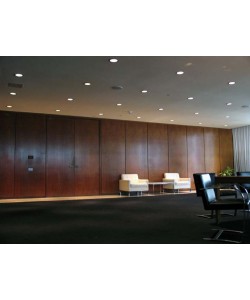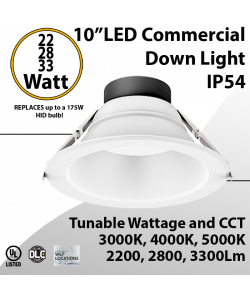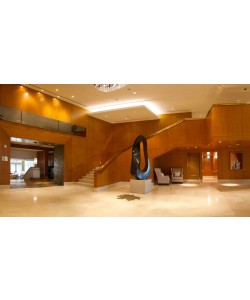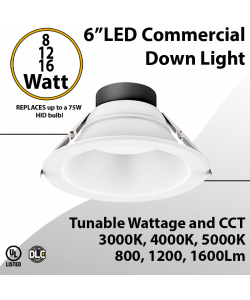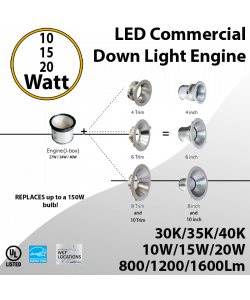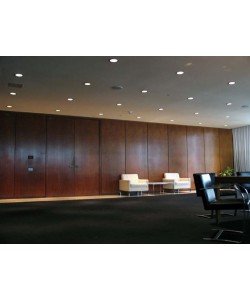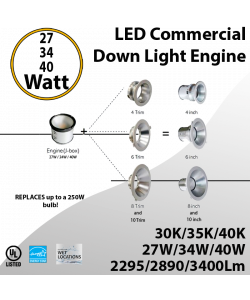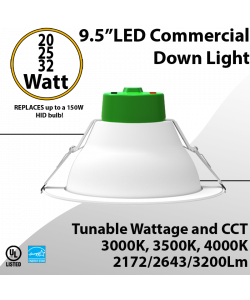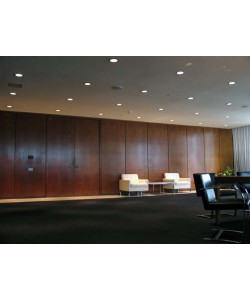Shopping Cart - 0 Item
You have no items in your shopping cart.
Commercial LED Downlights: LED Recessed Floor Lights
What you should know about recessed lighting and how to select the best fit for your application
Recessed lighting is without a doubt one of the most practical and functional upgrades you can make to your house or business. Recessed lighting is also known as downlighting or can lighting, is designed to be flush with the surface where it is installed (usually the ceiling). These lights are adaptable and can be used in a variety of settings. LED recessed lighting is the most common type of architectural lighting on the market today, and it's one of the easiest methods to modernize an existing space quickly. As LED recessed lighting suppliers, we're seeing it used sas much in new construction as in retrofit applications.
Click here to open the chat or call us to 844-533-7230 if you have any question regarding your need for Recessed Lighting or any other product.
-
Recessed Downlight Retrofit 6" 15W 1200Lm 120VAC CCT Selectable
Upgrade your space with the 6-Inch 15W Recessed Downlight Retrofit! This versatile LED offers 1200 lumens of brightness with five adjustable CCT settings (2700K to 5000K), combining energy efficiency and modern design. Perfect for homes, offices, and factories, it’s easy to install, durable, and eco-friendly. Enjoy powerful, customizable lighting for any environment with this all-in-one solution!
Click here to see other Down lights.
Learn More -
LED Downlight 4 inch Round Trim
The LED Downlight 4 inch Round Trim is a versatile lighting solution suitable for a variety of applications for residential, commercial, and industrial settings. The round trim design adds a sleek and modern touch to any space, while the DNF-ETN engine ensures reliable performance and longevity. With its easy installation process and low maintenance requirements, this LED downlight is an ideal choice for those seeking a cost-effective and eco-friendly lighting solution.
Click here to see other Downlights.
Learn More -
Recessed LED Light Fixture - 4" 9W Square Trim CCT Triac Dimmable
With a sleek square design and adjustable color temperatures ranging from 2700K to 5000K, this dimmable downlight offers tailored lighting solutions for any environment. Boasting Triac dimming compatibility and robust construction, it ensures efficient illumination and longevity. Ideal for residential and commercial applications, from accent lighting to task illumination, this downlight is easy to install and compatible with standard electrical systems. Upgrade your lighting experience with our reliable and energy-efficient LED downlight today..Shipped by 24 count box!
Click here to see other Down lights.
Learn More -
LED Baffle Recessed Downlight Round 3" 6W - Dimmable Lighting Solution
Learn More
This 6W downlight features a 3-inch diameter, delivering 440LM of luminous flux at 120V. With a convenient switch for effortless color temperature adjustment, choose from 2700K to 5000K to suit any environment. Ideal for living rooms, bedrooms, offices, lobbies, and conference rooms, its IC rated design ensures safety and efficiency without the need for recessed housings.
Click here to see other Down lights. -
LED Baffle Recessed Downlight Round 4" 9W - Dimmable Lighting Solution
Learn More
Illuminate any space with precision using our 9W Ultra-Slim Baffle Style Downlight with Tunable White Technology. Effortlessly adjust the color temperature from 2700K to 5000K to suit your environment, whether it's a cozy living room or a professional office. This downlight delivers uniform illumination while minimizing glare and shadows. Ideal for residential and commercial applications, it offers versatility and efficiency, backed by ETL and Energy Star certifications and a 5-year limited warranty.
Click here to see other Down lights. -
Recessed LED Light: 6 Inch 12W Square Trim 5 Dimmable Tunable CCT
Our CCT Tunable 12-Watt Square LED Downlight stands as an exemplar of innovation. Tailored to meet the exacting standards of contractors and electricians, this luminary amalgamates essential specifications and features, ensuring seamless integration into diverse residential and commercial settings. Our 12-watt square LED downlight stands as a beacon of innovation, offering a blend of essential specifications and features tailored to meet the demands of professionals in the field.
Click here to see other Down lights.
Learn More -
Dimmable Baffle Recessed Downlight Round 6" 12W
Enhance your environment with our 12W Ultra-Slim Baffle Style Downlight, designed with dynamic lighting control to tailor illumination to your preferences. Ideal for both residential and commercial use, this downlight boasts easy installation, robust build quality, and exceptional performance. With its dynamic spectrum technology, this sleek fixture allows you to sculpt your space with personalized lighting, whether it's for a cozy evening or a vibrant workspace. Illuminate your world, your way.
Learn More
Click here to see other Down lights. -
Reccesed Lighting 4" 9W LED Square Panel Selectable 5 CCT
The Recessed Lighting 4" 9W LED Square Panel features five selectable color temperatures (2700K, 3000K, 3500K, 4000K, 5000K) and energy-efficient 9W LED technology. Designed for 120V input with Triac dimming, it provides smooth dimming from 100% to 10%. This versatile panel is perfect for various residential and commercial applications.
Click here to see other Down lights.
Learn More -
Down Light for Recessed Lighting Ultra Thin LED Panel 4" 9W tunable white
LED recessed lighting made easy with these selectable white ultra thin slim dimmable panels. Set color temperature as desired to W=3000K, N=4000K or C=5000K and use any triac compatible dimmer to dim 0%-100% absolutely no flicker. These 9W ultra thin LED Down Lights are the ideal replacement for 4" can lights. As they come with junction box, the can is unnecessary. Easy to install. Save up to 75% in electricity and hundreds in unnecessary bulb replacements! Typical annual ROI > 70%
Click here to see other Down lights.
Learn More -
LED Downlight 6 inch Round Trim
Looking for high-quality LED downlights? Look no further than our commercial LED downlight trims! These trims are specifically designed to be used with our powerful DNF-ETN 20W and 40W engines, providing superior illumination for any space. Not only do these LED downlights offer exceptional brightness, but they are also highly energy-efficient, helping you save money on your utility bills over time. Plus, with their sleek and modern design, these trims are sure to complement any decor style.
Click here to see other Downlights.
Learn More -
Reccesed Lighting 6" 12W LED Square Panel Selectable 5 CCT
The Recessed Lighting 6" 12W LED Square Panel features five selectable color temperatures (2700K, 3000K, 3500K, 4000K, 5000K), offering customizable lighting options for various spaces. With energy-efficient 12W LED technology, it provides smooth dimming (100%-10%) and flicker-free performance. Ideal for modern homes and commercial spaces, this fixture combines functionality and sleek design for versatile indoor lighting.
Click here to see other Down lights.
Learn More -
Recessed Lighting can less LED Panel 6" 12W switchable white color temperature
LED recessed lighting made easy with these selectable white ultra thin slim dimmable panels. Set color temperature as desired to 3000K, 4000K or 5000K and use any triac compatible dimmer to dim down 100%-5%, no flicker. These 12W ultra thin LED Downlights are the ideal replacement for 6" can lights. As they come with junction box, the can is unnecessary. Easy to install. Save up to 75% in electricity and hundreds in unnecessary bulb replacements! Typical annual ROI > 40%.
Click here to see other Down lights.
Learn More -
LED Downlight 4 Inch Square Trim
The LED Downlight 4 Inch Square Trim is a modern recessed housing designed for sleek, directional lighting. Trim only—pair it with compatible LED engines (DNF-ETN 20166-SW or 40340-SW) for up to 3400 lumens, 0-10V dimming, and multiple color temperatures. Ideal for offices, retail, and hospitality spaces needing a clean, minimalist lighting solution.
Click here to see other Downlights
Learn More -
LED Downlight 4 Inch Round Wall Washer Trim
The LED Downlight 4 Inch Round Wall Washer Trim is a recessed housing designed for directional wall illumination. Trim only—combine it with compatible LED engines (DNF-ETN 20166-SW or DNF-ETN 40340-SW), available on our website. Perfect for offices, galleries, and retail spaces, it offers 0-10V dimming and delivers up to 3400 lumens of smooth, wall-washing light.
Click here to see other Downlights
Learn More -
LED Downlight 4 inch Square Wall Washer Trim
The LED Downlight 4 Inch Square Wall Washer Trim delivers clean, focused wall illumination in a compact square design. Trim only—pair it with DNF-ETN 20166-SW or 40340-SW engines for up to 3400 lumens, 0-10V dimming, and color temps from 3000K to 4000K. Perfect for retail, offices, and display walls.
Click here to see other Downlights
Learn More -
LED Gimbal Recessed Downlight 4" 9W - Triac Dimmable Lighting Solution
Learn More
Our LED Gimbal Recessed Downlight 4 Inch 9W offers lighting precision and efficiency for electricians and contractors. With its compact size and powerful 9W output, it delivers optimal illumination while minimizing energy consumption. Featuring Triac Dimmable Technology, users can effortlessly adjust brightness levels to suit any setting. Choose from a range of color temperature options to customize the ambiance, while the gimbal design allows for flexible light direction.
Click here to see other Down lights. -
LED Downlight 8 inch Round Trim
Looking for high-quality LED downlights? Look no further than our commercial LED downlight trims! These trims are specifically designed to be used with our powerful DNF-ETN 20W and 40W engines, providing superior illumination for any space. Not only do these LED downlights offer exceptional brightness, but they are also highly energy-efficient, helping you save money on your utility bills over time. Plus, with their sleek and modern design, these trims are sure to complement any decor style.
Click here to see other Downlights.
Learn More -
Round Downlight 8" 18W 1530Lm 5CCT Adjustable
This versatile LED downlight features 5CCT adjustable color temperatures (2700K-5000K), delivering 1530 lumens of energy-efficient lighting. With a sleek 8-inch design, glare-free illumination, and easy installation, it’s perfect for homes, offices, retail, and hospitality spaces. Upgrade your lighting today with this modern, adjustable, and cost-effective solution!
Click here to see other Down lights.
Learn More -
Round Downlight 8" 18W 1420Lm 5CCT Adjustable
Learn More
Upgrade your lighting game with our 18W Ultra-Slim Baffle Style Downlight. With tunable white technology and robust construction, this downlight ensures optimal illumination for any environment. Ideal for contractors and electricians, it seamlessly integrates into residential and commercial spaces, providing versatile lighting solutions with ease. Experience superior performance and efficiency today!
Click here to see other Down lights. -
Recessed downlight retrofit 6" 15W 1250Lm 100-277V Tunable Watt and CCT
Attention electrical contractors! Enhance your clients' spaces with our top-of-the-line recessed downlight retrofit solution. Our 6" 15W 1250Lm 100-277V tunable watt and CCT downlights are the perfect upgrade for any project. With adjustable wattage and color temperature, you can customize the lighting to suit any mood or requirement. Our team of experts is ready to provide seamless installation, ensuring optimal performance and energy efficiency. Don't miss out on this opportunity to offer your clients superior lighting solutions. Contact us now and revolutionize their spaces with our cutting-edge recessed downlights. Elevate your services and stand out from the competition today!Click here to see other Down lights.
Learn More -
Recessed Lighting Mounting Plate for T Grid
The Commercial Downlights Mounting Plate for T-Grid ceilings provides a secure and easy installation solution for LED downlights. Designed for compatibility with standard T-Grid systems, it ensures stability and professional alignment, making it ideal for offices, retail spaces, and commercial buildings.Click here to see other Light Poles, Adapters, Reducers and Tenons.
Learn More -
LED Downlight 6 inch Wall Washer Round Trim
The LED Downlight 6 Inch Wall Washer Round Trim is a recessed housing for directional wall lighting. Trim only—pair it with compatible LED engines (DNF-ETN 20166-SW or DNF-ETN 40340-SW), available on our website. Ideal for retail, galleries, and offices, with 0-10V dimming and up to 3400 lumens of soft, wall-washing light.
Click here to see other Downlights
Learn More -
LED Downlight 6 Inch Square Trim
The LED Downlight 6 Inch Square Trim is a recessed housing with a bold, modern look—perfect for highlighting larger interior spaces. Trim only—pair it with compatible LED engines (DNF-ETN 20166-SW or DNF-ETN 40340-SW), offering 10W to 40W, up to 3400 lumens, 0-10V dimming, and CCTs from 3000K to 4000K. Ideal for retail, hospitality, and office settings.
Click here to see other Downlights
Learn More -
LED Downlight 6 inch Wall Washer Square Trim
The LED Downlight 6 Inch Wall Washer Square Trim provides smooth, directional wall lighting in a modern square format. Trim only—pair it with compatible LED engines (DNF-ETN 20166-SW or 40340-SW) for up to 3400 lumens, 0-10V dimming, and 3000K–4000K color temperatures. Ideal for galleries, offices, and retail interiors.
Click here to see other Downlights
Learn More -
LED Downlight 10 inch Round Trim
Looking for high-quality LED downlights? Look no further than our commercial LED downlight trims! These trims are specifically designed to be used with our powerful DNF-ETN 20W and 40W engines, providing superior illumination for any space. Not only do these LED downlights offer exceptional brightness, but they are also highly energy-efficient, helping you save money on your utility bills over time. Plus, with their sleek and modern design, these trims are sure to complement any decor style.
Click here to see other Downlights.
Learn More -
LED Gimbal Recessed Downlight 6 Inch 12W Triac Dimmable
Learn More
Illuminate your space with precision using our LED Gimbal Recessed Downlight 6 Inch. This efficient 12W downlight boasts triac dimmable technology for customizable lighting. With 960 lumens output, it delivers ample brightness while minimizing energy consumption. The versatile gimbal design allows for easy adjustment of the light direction, making it perfect for highlighting artwork or architectural features. Choose from multiple color temperature options ranging from 2700K to 6000K to create the desired ambiance.
Click here to see other Down lights. -
LED Gimbal Recessed Downlight 2" 5W Round Trim 27K to 50k Triac Dimmable
Spotlight in Style – 2” This 5W LED gimbal downlight offers adjustable directional lighting with 5 selectable color temperatures (2700K–5000K). Its sleek round trim, Triac dimming, and compact size make it ideal for modern ceilings, accent lighting, and small spaces. Energy-efficient and easy to install, it’s a smart solution for stylish, flexible illumination.
Click here to see other Down lights.
Learn More -
LED Gimbal Recessed Downlight 6" 12W 2700K to 5000K Triac Dimmable
Focus & Flexibility – 6” This 6” 12W LED Gimbal Recessed Downlight offers 995 lumens, 5 selectable CCTs (2700K–5000K), and Triac dimmable technology. Its adjustable round trim design provides flexible, directional lighting with a modern look. Ideal for homes or commercial spaces seeking energy-efficient, long-lasting performance with precise beam control and elegant style.
Click here to see other Downlights.
Learn More -
LED Downlight 4 inch 5.5W//8W/12W 480/709/1028Lm 30K/35K/40K 0-10V Dimmable
Elevate your commercial space with our advanced LED Downlight 4 inch. Offering tunable color temperature (CCT) and adjustable wattage, including 10V dimmability, it provides unparalleled customization. Transform ambiance with ease, from cozy warm to vibrant cool hues. Enhance energy efficiency and create the perfect mood for any setting. Damp Location.Click here to see other Down lights.
Learn More -
LED commercial down light 6inch 12/17/22W 2030lm 100-277V 27/30/35/40/50K
Looking for an efficient lighting solution for your commercial space? Look no further than our LED commercial down light! With selectable wattage and CCT options, you can customize your lighting to fit your specific needs. Choose between 12/17/22 watts and 2030 lumens to achieve the perfect level of brightness, while the 100-277V range ensures compatibility with most electrical systems.
Click here to see other Down lights.
Learn More -
LED Downlight 6 inch 7W//10W/18W 756/1062/1606Lm 30K/35K/40K 0-10V Dimmable
Elevate your commercial space with our versatile LED Downlight 6 inch. Featuring Tunable Wattage, CCT, Lm, and 0-10V Dimmable technology, it offers precise control over brightness, color, and ambiance. Transform your environment effortlessly, from focused work settings to relaxed atmospheres. This commercial down light is easy to install and provides long-lasting, energy-efficient lighting that will save you money on your electric bill.
Click here to see other Down lights.
Learn More -
LED commercial down light 8inch 17/24/30W 2790lm 100-277V 27/30/35/40/50K Dimmable
Set color temperature as desired to 2700K, 3000K, 3500K, 4000K or 5000K and use any 0-10V compatible dimmer to dim down 100%-0%, no flicker. These LED retrofit Downlights are the ideal for 8" can lights and can be preset to 17/24 or 30W. Easy to install. Save up to 75% in electricity and hundreds in unnecessary bulb replacements! Typical annual ROI > 40%. LEDRADIANT Downlights have a lifespan over 15 years, maintenance-free, if used 12 hours a day.
Click here to see other Down lights.
Learn More -
Recessed Downlight Round 8" Baffled 18W 1800Lm 100-277V 5CCT 0-10VDC Dimmable
Upgrade your lighting projects with the Recessed Downlight Round 8" Baffled 18W. Designed for electrical contractors, this energy-efficient fixture operates on 100-277V and offers 5CCT adjustable color temperatures (2700K, 3000K, 3500K 4000K, 5000K), providing flexibility for any space. Its baffled design reduces glare, delivering smooth, even lighting for residential or commercial applications. Ideal for retrofit or new installations, this downlight ensures easy integration and energy savings. Compatible with 0-10Vdc dimmers.
Click here to see other Down lights.
Learn More -
LED commercial down light 10inch 22/30/38W 3530lm 100-277V 27/30/35/40/50K Dimmable
Elevate your electrical projects with our high-performance 10-inch LED Commercial Downlight. With options of 22/30/38W, 3530 lumens, 100-277V compatibility, 0-10V dimmer compatible and selectable CCT 27/30/35/40/50K, it's perfect for diverse commercial spaces. Enhance efficiency and ambiance while reducing energy costs. Don't miss out on this lighting solution. Contact us today for pricing and details. Illuminate your projects brilliantly!
Click here to see other Down lights.
Learn More -
LED Downlight 8 inch 10W/15W/22W 1067/1560/2073Lm 30K/35K/40K 0-10V Dimmable
Elevate your commercial space with our advanced LED Downlight 8 inch. Featuring Tunable Wattage, CCT, Lm, and 0-10V Dimmable technology, it offers unparalleled lighting customization. Transform your environment effortlessly, from focused work settings to inviting atmospheres.This commercial down light is easy to install and provides long-lasting, energy-efficient lighting that will save you money on your electric bill.Click here to see other Down lights.
Learn More -
LED Downlight 10 inch 22W/28W/33W 3300Lm 30K/40K/50K 0-10V Dimmable
Upgrade your lighting with our LED Downlight 10 inch! Our downlight is selectable in three wattage options (22W/28W/33W) and three color temperatures (30K/40K/50K) to suit your needs. With a brightness of 3300Lm, our downlight is perfect for illuminating any space. Plus, it's dimmable with a 0-10V dimmer switch for added convenience. Our LED Downlight 10 inch is energy-efficient and long-lasting, making it a great choice for your home or office. Order now and experience the difference!
Click here to see other Down lights.
Learn More -
LED Downlight 6 inch 8W/12W/16W 1600Lm 30K/40K/50K 0-10V Dimmable
Ready for recessed mounting. Easy to install from below the ceiling, secured by two tension clips. Make them dimmable with any 0-10 VDC dimmer. Select Color temperature 3000K, 4000K or 5000K and the wattage 8W, 12W or 16W for correlating brigthness.
Click here to see other Down lights.
Learn More -
LED Down light Engine 10W 15W 20W 1660Lm 30K/35K/4000K 0-10 Dimmable
Select three different wattage options - 10W, 15W, and 20W - this LED downlight delivers up to 1660 lumens of bright and vibrant light. With a dimmable feature and customizable color temperatures of 3000K, 3500K, and 4000K, this downlight provides you with greater control over the ambiance of your space. Its energy efficiency and long lifespan make it a cost-effective investment for any commercial setting. Easy to install, this LED downlight is compatible with 4-inch t0 10-inch housings.
Click here to see other Down lights.
Learn More -
LED Down light Engine 27W/34W/40W 3400Lm 30K/35K/4000K 0-10 Dimmable
Ready for recessed mounting, easy to install from below the ceiling, secured by two tension clips. Wattage selectable 27W, 34W and 40W and CCT tunable 3000K, 3500K and 4000K also dimmable with any 0-10 VDC dimmer. The light engine/J-box can be detached from the trim and attached to a different one. Save up to 75% in electricity and hundreds in unnecessary bulb replacements! Typical annual ROI >40%. LEDRADIANT Down lights are dimmable with a lifespan over 15 years, maintenance free, if used 12 hours a day.
Click here to see other Downlights.
Learn More -
LED Downlight 9.5 inch 20W//25W/32W 2172/2643/3200Lm 30K/35K/40K 0-10V Dimmable
Elevate your business space with our cutting-edge LED Downlight 9.5 inch. Boasting Tunable Wattage, CCT, and Lm, along with 0-10V Dimmable technology, it offers unprecedented lighting adaptability. Seamlessly transition from task-oriented to ambient lighting, transforming your environment effortlessly.This commercial down light is easy to install and provides long-lasting, energy-efficient lighting that will save you money on your electric bill.
Click here to see other Down lights.
Learn More
What are Recessed Downlights?
LED Downlights are lights that usually have been recessed into a ceiling and are designed to illuminate downwards. They are ideal to illuminate any kind of place where a distinctive lighting touch is needed (living areas, bedrooms, bathrooms, kitchens, lounges, and even underneath benches and cabinetry). A simple 9W LED Downlight can replace a 40W CFL and even a 100W Incandescent! All you need is enough room to put the housing. Some LED ceiling light fixtures are dimmable. They are sometimes referred to as recessed lights, pot lights, or can lights. The LED downlights can shine down broadly to light up a whole area or narrowly like a spotlight. When it comes to looks, they provide a modern appearance to the room. Our LED downlights are clear, streamlined, and great if you don't want a pendant or a bulky light fixture in the room.
Recessed Downlights: When and Where to Use Them
In both indoor and outdoor applications, recessed lighting can provide a variety of lighting effects. For spaces with little ceiling space or where a large fixture would be intrusive, recessed downlights are the ideal option. When used in conjunction with other fixtures such as pendants and under cabinet lighting, recessed downlights may provide excellent task lighting as well as ambient light for any room. Recessed lights are perfect for hallways and corridors, they can be paired with sconces or step lights because of their small size. Outdoor-rated downlight fixtures can illuminate porches, patios, soffits, and other outdoor places such as gazebos, galleries and corridors.
We offer several LED alternatives to select from, whether you're trying to save money by retrofitting or going with an entirely new scheme. Choosing the correct fixture for your application can be difficult with so many sizes, styles, finishes, and special features to choose from. With this guidance, you'll be able to figure out which low-profile fixture is right for your application.
Choosing the Most Appropriate Recessed Lighting
In order to select the suitable fixture for new construction or remodel projects, numerous criteria must be considered, including function, operation, and spatial arrangement (more on that later). A recessed light is often defined by three primary components: housing, trim style, and lamp type (in this case, LED). Many LED recessed fixtures are now available as a 'kit,' which includes the housing, trim, and LED module all in one handy package. Recessed lighting kits are available in a variety of sizes and styles. The most common type of kit is the line voltage kit, which uses 120 volts, but some commercial applications may be powered with 220 or 347 Volts. A driver is used to lower the voltage in low voltage kits. The driver can be integrated into the fixture or stand-alone. LED retrofit kits, as previously mentioned, allow you to convert traditional recessed lights to LED while keeping the original housing, usually called a can.
When choosing the correct LED fixture, there are several factors to consider, including size, trim, and color temperature. However, the first decision you'll have to make is whether to replace old fixtures with new ones and save money by retrofitting. Removing the original bulb and trim and putting in an LED module adapter into the socket is typically all that is required to install an LED conversion kit into existing housing. LEDs will typically save 85 percent more energy than incandescent bulbs, and they will also emit significantly less heat, thus reducing the cost of A/C. LEDs are almost maintenance-free since they have a considerably longer lifespan than traditional bulbs, normally more than ten times longer. Measuring the diameter of your existing cut-out, excluding the trim, is a simple way to determine the size (the visible portion of the fixture). Many of today's models may be used in new construction as well as retrofit applications, providing you even more alternatives.
The housing is the section of the downlight fixture that is hidden above the ceiling and encloses all of the downlight fixture's components. As previously stated, the housing can be a separate component or it can be included in the entire fixture. New construction housing is utilized in new construction or remodel applications, either before or after the ceiling is built. Insulated housings (IC rated) allow the recessed light to come into direct touch with the insulation above the ceiling. A minimum of 3 inches of space from the insulation is required for non-IC housing. The air movement between the unconditioned space above (typically the attic) and the conditioned room below is reduced by airtight (AT) certified recessed lights, which can be IC or non-IC rated. This is important for saving money on heating and cooling as well as reducing moisture concerns. The majority of today's LED recessed fixtures feature both IC and AT ratings.
Ultra thin LED Recessed Panels
Ultra thin LED downlights don't require any housing. These fittings, which range in size from 3 to 12 inches, are ideal for ceilings with a shallow plenum (the space that allows for air circulation for heating and cooling). Because of their small size, they may be installed in tight spaces like under overhangs and eaves, as well as directly under joists for maximum arrangement freedom. Not only is housing not necessary, but you also don't need access to the above ceiling for installation because many are only a half-inch thick. LED downlights that are very thin and ultra-thin are IC rated, which means they emit very little heat and don't require a gap between the fixture and the insulation. As a result, they can be used in both new and renovation projects.
These ultra-thin LED recessed Lights are very easy to install, simply cut a hole in the ceiling and snap the fixture into place with the accompanying spring clips, eliminating the need for housing. Once the hole is cut, installation takes only a few minutes, and they're perfect for store ceilings, hallways, bedrooms, living rooms, and kitchens. You also get all of the advantages from LED lighting, such as a longer lifespan, lower maintenance expenses, and lower energy use. Most thin panels have a separate remote driver box, while others are all in one. You'll find extensive instructions once you select a product from our catalog.
Lighting Color Temperature and Dimming
Color temperature and intensity can all have an impact on your area, making it a place where you'll genuinely want to spend time. We have various LED recessed lights that are white color-tunable 2700K, 3000K, 4000K or 5000K and dimmable with a regular "triac" dimmer, thus no need for additional wiring is required.
Size, Layout and Spacing
The size of your fixture will be determined by the height of your ceiling, the purpose and the square footage of the room. Keep in mind that when it comes to fixture placement personal taste and design aesthetic can occasionally suffice. One recessed light for every 4 to 6 feet of ceiling space is a popular rule of thumb. Fixtures should typically be 24 inches away from a wall or cabinet, with 2 to 5 feet between them. Keep in mind that you won't need as much light in a bedroom as you would in a kitchen and much more for a retail area. The height of the ceiling is very important to determine the number of fixtures and the lumens that each fixture provides.
Residential recessed downlights are typically 4 to 7 inches in diameter. A 6-inch fixture is the most common size. As a result, there are frequently more 6-inch varieties to pick from. Larger diameters, usually 6 inches or more, are often required for higher ceilings. In general, the larger the diameter of your fixture, the larger the light wash it produces. For commercial use, most of the lights will be 6, 8 or sometimes 10 inches.
6-inch lights are perfect for providing light above counters with ample output. When installing recessed lighting in a kitchen, pay special attention to regions not illuminated by other fixtures such as pendants or under cabinet lighting. Consider where your high-traffic locations are located and concentrate your lighting efforts there. A single row of suitably placed downlights will boost your ambient lighting strategy in galley-style kitchens or walks around an island. A grid design might be your best option for even illumination throughout a wall-to-wall kitchen with nothing in the middle.
When determining spacing, install downlight fixtures at least 2 feet away from walls and cabinets to minimize a spotlight effect on vertical surfaces. Too much space, on the other hand, can result in shadows all over the room. Use a dimmer for better lighting control.
Retrofit Kits for LED Recessed Lighting
LED conversion kits for recessed lighting can be put into existing fixtures by removing the original bulb and trimming it before fitting in an LED module adaptor. You can quickly update your present plan into a more efficient and powerful option for your business or home with our led retrofit kits for recessed lighting.
With all these variables, how do I know what I need?
When shopping for led retrofit recessed can lights, you should think about the type of bulb as well as the wattage to find the ideal match. For example, we have LED retrofits that replace 60W and 80W incandescent lamps, as well as 50W to 90W halogen lamps. When selecting an LED counterpart for your fixture, you'll have a range of wattage options ranging from 8W to 15W, depending on model characteristics. As a rule of thumb, each watt of LED light fixture equals 8 to 10 watts of incandescent or halogen bulb. Regardless of which wattage is best for your space and fixture type, you can rest confident that each option is a high-performing solution that will let you modernize your fixtures with the power of LED.
Advantages of Retrofit LED Recessed Lights
Retrofitting recessed lights is a more convenient and cost-effective option than replacing the entire recessed lighting fixture. Retrofitting recessed lights can be as simple as changing a light bulb in some cases. If the trims match the ceiling or if the ceiling was painted after the installation, sometimes removing the old fixtures will damage the paint, in this case retrofitting would be a better option to avoid re-painting.
LEDs used in recessed lighting retrofit kits have progressed to the point where there are no disadvantages of LED technology. Color rendering, color temperature, and light output are all significantly improved compared to wattage used qith incandescent or halogen lighting.
LED can light retrofits have a substantially longer lifespan than other varieties, which means they need to be replaced less frequently. This is especially crucial when it comes to ceiling lighting, where the fixtures may be difficult to reach.
Although LED lighting is more expensive at the time of purchase, the savings are more than offset over time due to the fact that they use far less energy than traditional lights. Over time, this saves money on utility bills. They are also more efficient, emitting much less heat.
Consult with us before you buy
Do not hesitate and click here to open the chat or call us to 844-533-7230 if you have any question regarding your need for LED Recessed Lights or any other product.





